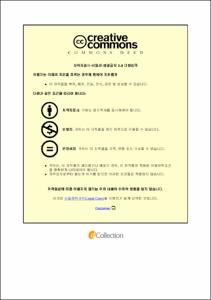표면코팅용 수분산 폴리우레탄의 합성과 응용에 대한 연구
- Alternative Title
- A Study on the Synthesis and Applications of Waterborne Polyurethane Dispersions for Surface Coating
- Abstract
- Since most of the coatings have been prepared by organic solvents, there are many regulations because of the environmental and health hazards caused by volatile organic compounds. As an alternative to organic solvent-based polyurethanes which are broadly used in coatings, waterborne polyurethane dispersions are receiving great attendance due to their harmless to humans and environment.
In the first chapter, water-dispersed UV-curable polyurethane acrylates (PUAs) were synthesized by varying content of reactive silicone which gives surface hydrophobicity. The physical properties of the synthesized PUAs were measured as a function of content of silicone. The molecular structure and physical properties of the synthesized water-dispersed UV-curable PUAs were investigated by FT-IR and contact angle, surface energy, particle size, tensile strength, and elongation. The results showed that as the content of reactive silicone increased, the surface energy of the cured coating decreased due to the hydrophobicity of silicone. The optimum physical properties were obtained by controlling content of reactive silicone.
In the second chapter, waterborne UV-curable PUAs were synthesized with different ratios of 4,4-methylene dicyclohexyl diisocyanate (H12MDI) and isocyanate-functionalized aliphatic acrylic ester (IAAE). Physical properties of the synthesized PUAs were measured as a function of mixing
ratio. Molecular structure and physical properties of the synthesized waterborne UV-curable PUAs were investigated by FT-IR and analyzers on particle size, tensile strength, pencil hardness, and adhesion. The results showed the tensile strength and pencil hardness of the cured coatings increased with IAAE while their elongation decreased. These trends would be due to the high reactivity of IAAE which leads to high curing density. The optimum physical properties were obtained by controlling the mixing ratio.
In the third chapter, to develop eco-friendly coatings on poly(vinyl chloride) (PVC), various WPUDs were synthesized by combination of polyol such as polyester, polycaprolactone, polyether or polycarbonate, hydrophilic compounds (dimethylol butanoic acid, DMBA), and reactive silicone. PVC is widely used in car seat covers because of low price and good heat and fire resistance. The structure and properties of synthesized WPUDs were characterized by FT-IR, particle size, contact angle, surface energy, tensile strength, elongation, and adhesion strength. Also, their particle sizes decreased while tensile strengths increased with increasing DMBA content. Surface energy and contact angle of WPUDs were strongly affected by the content of hydrophobic reactive silicone. The optimum properties of WPUDs were obtained by controlling their compositions, polyol, hydrophilic compound, and reactive silicone.
- Issued Date
- 2021
- Awarded Date
- 2021. 8
- Type
- Dissertation
- Publisher
- 부경대학교
- Alternative Author(s)
- SONG SAM CHA
- Affiliation
- 부경대학교 대학원
- Department
- 대학원 화학융합공학부
- Advisor
- 이원기
- Table Of Contents
- Ⅰ. 서 론 1
1. 연구목적 및 배경 2
2. 이론적 배경 5
1) 폴리우레탄 5
2) 수성 폴리우레탄 11
3) UV경화 시스템 25
Ⅱ. 반응성 실리콘 변성 수분산 폴리우레탄의 합성과 물성 35
1. 서론 36
2. 실험 37
1) 시약 및 기기 37
(1) 시약 및 재료 37
(2) 기기 38
2) 수분산 폴리우레탄의 합성 39
3) 수분산 폴리우레탄의 분석방법 44
(1) 구조분석 44
(2) 접촉각과 표면에너지 44
(3) 점탄성과 인장강도 44
(4) 입자크기 분석과 점도 44
3. 결과 및 고찰 46
1) 구조분석 및 UV경화 46
2) 접촉각과 표면에너지 49
3) 점탄성과 인장강도 51
4) 입자크기와 점도 54
4. 결론 60
Ⅲ. 기능성 이소시아네이트 도입 자외선경화형 수분산 폴리우레탄의 합성과 물성 61
1. 서론 62
2. 실험 64
1) 시약 및 기기 64
(1) 시약 및 재료 64
(2) 기기 65
2) 자외선경화형 수분산 폴리우레탄의 합성 66
3) 자외선경화형 수분산 폴리우레탄의 분석방법 73
(1) 구조분석 73
(2) 입자크기 분석과 점도 73
(3) 부착성 73
(4) 인장강도 73
(5) 점탄성 74
(6) 연필경도 74
3. 결과 및 고찰 75
1) 구조분석 및 UV경화 75
2) 입자크기와 점도 78
3) 부착성과 연필경도 78
4) 인장강도 79
5) 점탄성 79
4. 결론 83
Ⅳ. PVC 표면코팅용 수분산 폴리우레탄의 합성과 물성 84
1. 서론 85
2. 실험 87
1) 시약 및 기기 87
(1) 시약 및 재료 87
(2) 기기 88
2) 수분산 폴리우레탄의 합성 89
3) 수분산 폴리우레탄의 분석방법 93
(1) 구조분석 93
(2) 입자크기 분석과 점도 93
(3) 접촉각과 표면에너지 93
(4) 점탄성과 인장강도 93
(5) 부착성 96
(6) 첨가제 배합 물성 96
3. 결과 및 고찰 97
1) 구조분석 97
2) 입자크기와 점도 100
3) 접촉각과 표면에너지 102
4) 점탄성과 인장강도 104
5) 부착성 107
6) 첨가제 배합 물성 107
4. 결론 117
Ⅴ. 결론 118
참고문헌 122
- Degree
- Doctor
- Files in This Item:
-
-
Download
 표면코팅용 수분산 폴리우레탄의 합성과 응용에 대한 연구.pdf
기타 데이터 / 3.56 MB / Adobe PDF
표면코팅용 수분산 폴리우레탄의 합성과 응용에 대한 연구.pdf
기타 데이터 / 3.56 MB / Adobe PDF
-
Items in Repository are protected by copyright, with all rights reserved, unless otherwise indicated.